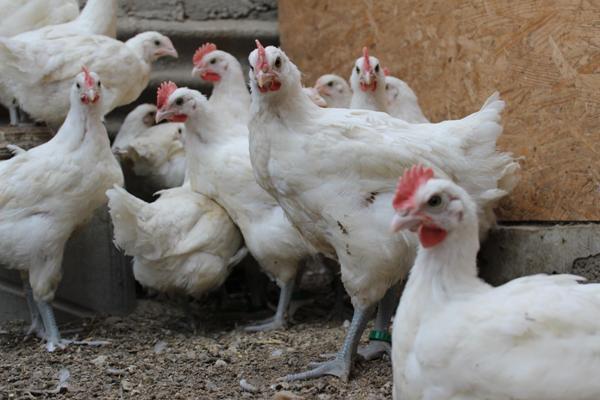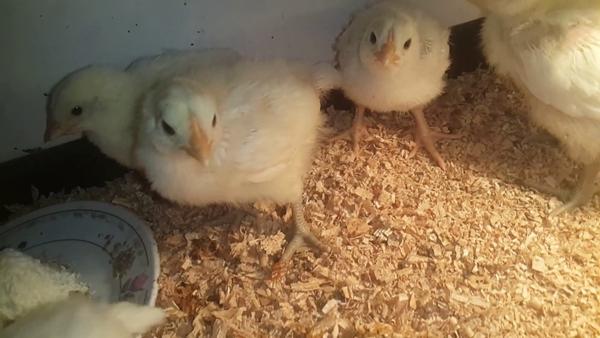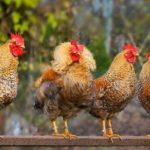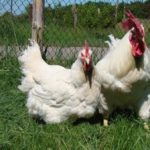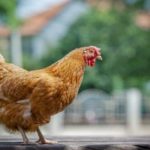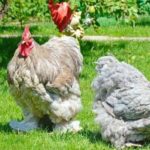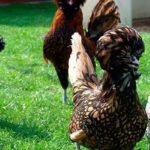The Bress Gali breed of chickens is very popular among many farmers. Birds are distinguished by their high productivity, decorative appearance and rapid growth. To achieve success in growing them, it is worth properly arranging the chicken coop. Providing a balanced diet and proper care for birds is of no small importance. That’s why it’s so important to follow the basic recommendations of experts.
- Description and characteristics of Bress Galskaya chickens
- Appearance and breed standards
- Origin and features
- Maturation of chickens
- Egg production
- Character
- Hatching instinct
- Main advantages and disadvantages
- Specifics of maintenance and care
- Poultry house requirements
- Walking area, feeders and drinking bowls
- Molting and break in egg production
- Planned herd replacement
- Diet of chickens and adult birds
- Subtleties of breeding
- Common diseases and prevention from them
- Analogs
Description and characteristics of Bress Galskaya chickens
This breed of chicken is characterized by certain characteristics. You should definitely familiarize yourself with them before starting to breed birds.
Appearance and breed standards
The careful work of breeders made it possible to obtain unique birds, which are characterized by the following exterior features:
- Large build. Birds have a powerful torso, strong wings, and developed muscles.
- Dense plumage. Chickens are characterized by thick white feathers and a thick layer of down. Thanks to this, the birds are reliably protected from the cold. Such feathers ensure the maintenance of proper thermoregulation.
- Strong legs. They have an unusual blue color. Sometimes there are birds with steel-colored legs.
- Small head. It is decorated with a straight red comb with 5-6 teeth. The birds also have small red earrings and expressive eyes with an orange arch. They are characterized by a strong beak of a bluish color.
The standard requirements for keeping chickens include the following:
- free walking should be at least three quarters of the time;
- each bird has a specific walking area - at least 10 square meters;
- The basis of the birds' diet should be corn.
Origin and features
Bress Gali chickens appeared in Russia relatively recently - in 2013. In France, these birds were known back in the Middle Ages. The first information about this breed appeared in 1591. By 1900, due to many crossings, the breed almost disappeared.
Local breeders managed to create an official standard for this breed in 1904. As a result, the population began to gradually increase.The gray birds appeared first, then the white ones. After this, a black variety was bred and, lastly, a blue one.
Today such chickens are very popular. They are characterized by rapid development and excellent egg production. At the same time, the meat of such chickens has many advantages - it has a delicate consistency and a pronounced milky taste.
Maturation of chickens
Chickens are characterized by rapid development and early maturation. Already at 1 month, the chicks reach 600 grams and are completely covered with feathers. At 3 months, the birds weigh 1.5 kilograms. Four-month-old chickens weigh 2.5 kilograms.
As a result, chickens reach a weight of 3.5 kilograms, and roosters weigh 5 kilograms.
Egg production
Chickens of this breed are distinguished by excellent egg production. Under normal conditions, chickens produce 180-240 eggs per year. They begin to lay eggs quite early - from six months. The eggs are round in shape and large in size. They weigh 60-85 grams. The shell can be white or soft cream.
Character
Birds have a peaceful nature. Chickens have a friendly disposition. They communicate well with people and other birds. However, birds often suffer from claustrophobia. Therefore, they require sufficient space for walking.
Birds have excellent adaptive characteristics. After changing their place of residence, they quickly adapt to new conditions.
Hatching instinct
Chickens of this breed have a well-developed maternal instinct, which is why they can hatch chicks. This is a rather unusual feature, since modern hybrid birds often have suppressed maternal instincts.
Main advantages and disadvantages
The key advantages of this breed include the following:
- delicacy properties of meat;
- high precocity;
- versatility of purpose - birds can be bred for eggs or used as an alternative to broilers;
- excellent vitality parameters - in comparison with broilers, birds have stronger immunity.
The disadvantages of the breed include the following:
- the possibility of purchasing purebred chickens only in French breeding farms;
- expensive fattening in compliance with traditional technologies.
Specifics of maintenance and care
To achieve success in raising these chickens, you should follow a number of recommendations.
Poultry house requirements
It is recommended that birds be provided with a warm and dry place to live. It should be well ventilated. A prerequisite is the presence of comfortable perches that are not very high.
It is also permissible to keep birds on the floor. At the same time, it is important to monitor the condition of the deep litter and systematically change it. It is recommended to insulate the floor of the chicken coop with straw, sawdust or shavings.
If you mix insulation with droppings, you will be able to release heat. This will help save on heating costs.
It is worth worrying about organizing dust baths. To do this, use containers with clay, sand, and ash.
Walking area, feeders and drinking bowls
Chickens of this breed fly well and do not tolerate cramped conditions well. Therefore, they require a spacious area for walking. It should be fenced with a high fence and a canopy made in the form of a grid. It is definitely worth equipping feeders and drinking bowls.
Molting and break in egg production
The molting process in chickens usually begins in the spring. In this case, birds almost completely lose their feathers. During the molting period, birds stop laying eggs. The owner must provide the chickens with proper nutrition and access to clean water. In addition, birds should be isolated from other individuals.
When changing feathers, it is worth reducing the amount of foods high in vitamins A and E. The amount of fish oil is also reduced. Every day, birds should be given wheat, corn and other foods that contain a lot of protein and fiber.
Molting lasts 2.5-3.5 months. Then the birds' condition returns to normal. At the same time, their productivity is restored.
Planned herd replacement
This procedure is carried out at intervals of 2 years. By this period, the productivity of laying hens decreases, so they should be replaced with young chickens.
If birds are raised for meat, they are changed depending on personal preference. It is permissible to release such chickens for slaughter from 5 months. Roosters are slaughtered no earlier than eight months of age.
It is recommended to completely rejuvenate the herd at at least five-year intervals. In this case, it is worth choosing the strongest and healthiest individuals.
Diet of chickens and adult birds
Chicks of this breed are characterized by rapid development and rapid weight gain. To do this, chickens need high-quality nutrition. The diet is made taking into account the following features:
- On the first day, the birds are given a boiled egg. It is recommended to grind it.
- On the second day, chopped green onions are introduced.
- From the 5th day of life, low-fat cottage cheese, boiled carrots, and small cereals are given. Crushed eggshells should be added to the food.
- At 1.5 weeks, foods that contain a lot of proteins are required. They help increase muscle mass. For this purpose, vegetable mash, fermented milk products, fruits, fish and meat and bone meal are used.
- At 1.5 months, chickens are allowed to be given food intended for adults.
In the first days of life, chickens need a glucose solution.To do this, 100 grams of the substance should be mixed with 2 liters of water. After this they are given plain water. It is recommended to change it every day.
The basis of the diet of chickens of this breed is considered to be compound feed. It is a composition based on cereals and useful elements. You can buy such food in a specialized store. You can also easily make it yourself. To do this, mix wheat, corn, sunflower meal, minerals and meat and bone meal in a ratio of 4:3:1:1:1. 1 bird requires 120 grams of the substance per day.
During their free range, birds eat a very varied diet. In addition to basic food, chickens need fresh greens and grass. They are also given chopped fruits, vegetables and root vegetables.
In winter, instead of succulent feed, grass meal is used. You can also give your birds chopped cabbage and beets. Shredded boiled potatoes are introduced into the diet in moderation. Shells in the form of powder, chalk and shells are also added to the feed.
To replenish the deficiency of vitamins and minerals, premixes are introduced into the diet. It is recommended to feed chickens sprouted grains - oats, barley, wheat, rye.
Subtleties of breeding
Chickens begin to lay eggs at 6 months, while roosters mature only at 1 year. In order for the fertilization of eggs to be maximum, there should be no more than 12 females per 1 male.
The hens of this breed retain the brooding instinct, which is why they cope well with the role of mother. If you want to get a guaranteed result, you should use an incubator.
Chickens are characterized by a fairly high survival rate. It is up to 98%. About 85% of birds survive to adulthood.
Common diseases and prevention from them
Diseases usually develop when kept in a cold environment, drafts, temperature fluctuations or overcrowding. Birds of this breed often suffer from colds.
They are characterized by mucous discharge from the beak, shortness of breath, increased breathing, and weakness. Loss of appetite and thirst are common. Biomycin or Tetracycline are used to combat disorders.
Chickens affected by coccidiosis should be disposed of, since this pathology cannot be treated. Then it is recommended to disinfect and ventilate the chicken coop.
Of the parasites that pose a danger to birds, lice, feather eaters, and bedbugs are dangerous. Pests multiply in conditions of high humidity and crowding of birds. Karbofos will help cope with the problem. Feathers are treated with it three times, with an interval of 1 week.
Analogs
The Jirsi giants, which are the largest in the world, are considered an analogue of this breed. These are meat chickens that are highly productive. Birds produce 200-240 eggs per year.
The Bress Galskaya chicken breed is well-deservedly popular among farmers. Birds are highly productive and have tender and tasty meat. To achieve good results in their cultivation, it is necessary to properly care for the birds.


